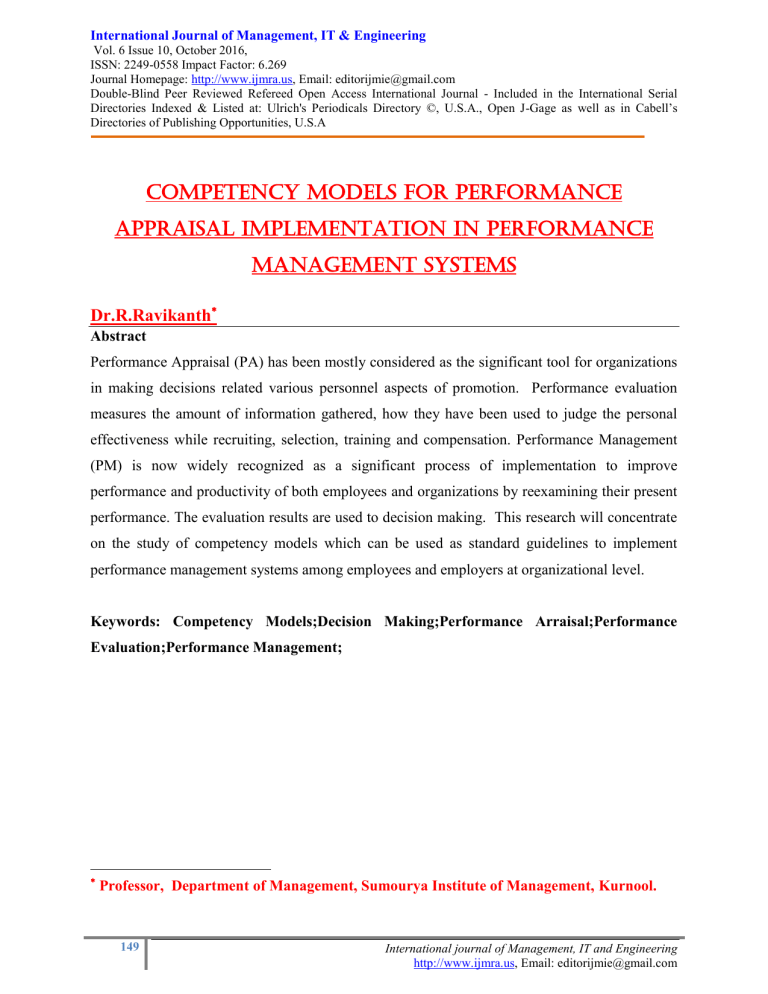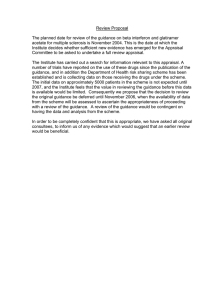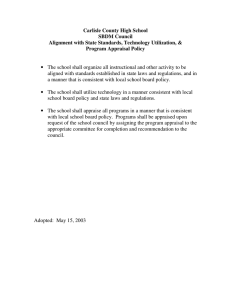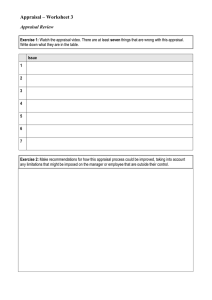IJMRA-10572
advertisement

International Journal of Management, IT & Engineering Vol. 6 Issue 10, October 2016, ISSN: 2249-0558 Impact Factor: 6.269 Journal Homepage: http://www.ijmra.us, Email: editorijmie@gmail.com Double-Blind Peer Reviewed Refereed Open Access International Journal - Included in the International Serial Directories Indexed & Listed at: Ulrich's Periodicals Directory ©, U.S.A., Open J-Gage as well as in Cabell’s Directories of Publishing Opportunities, U.S.A Competency Models for Performance Appraisal Implementation in Performance Management Systems Dr.R.Ravikanth Abstract Performance Appraisal (PA) has been mostly considered as the significant tool for organizations in making decisions related various personnel aspects of promotion. Performance evaluation measures the amount of information gathered, how they have been used to judge the personal effectiveness while recruiting, selection, training and compensation. Performance Management (PM) is now widely recognized as a significant process of implementation to improve performance and productivity of both employees and organizations by reexamining their present performance. The evaluation results are used to decision making. This research will concentrate on the study of competency models which can be used as standard guidelines to implement performance management systems among employees and employers at organizational level. Keywords: Competency Models;Decision Making;Performance Arraisal;Performance Evaluation;Performance Management; Professor, Department of Management, Sumourya Institute of Management, Kurnool. 149 International journal of Management, IT and Engineering http://www.ijmra.us, Email: editorijmie@gmail.com ISSN: 2249-0558 Impact Factor: 6.269 1. Introduction Performance management systems are an integration of performance appraisal and employee development, which are the assets and weakness of human resources management. They suffer a mark in many organizations, with both employees and managers performance ineffectiveness. Watson Wyatt survey showed that only 70 percent of workers agree that their company’s performance management system does not help to improve performance. Less than 40 percent of employees obeyed that their established management systems with clear performance goals, generated with truthful feedback to streamline the process. While these results suggest that the performance management systems in many organizations are designed poor, with poorly developed tools and processes. These may in tern cause difficulties with performance management and often threatening process for both employees and managers. Organizational managers are reluctant to provide candidates feedback and have discussions with employees honestly for fear of damaging relationships with every individual they get work done. Employees do not feel that their managers are unskilled to discuss their coaching ineffective and performance and how to develop their skills. Many one will consider that performance management systems are too time consuming and not value added. This leads both employees and managers to treat performance management as an unnecessary evil of work life that should be minimized instead of an important key process to achieve individual and organizational better outcomes. In spite of these hazards, performance management is implemented as an essential tool for organizations, and feels to be one of a manager’s most important responsibilities. Furthermore, performance management of an organization, its managers and employees can result in many important outcomes. In this paper, we especially concentrated on performance appraisal (PA) which is one of the major aspects of performance management. A performance appraisal is a periodic and systematic process followed to assess an individual employee's working performance and productivity based on certain pre-established criteria and objectives of the individual organization. In some cases other aspects of individual employees like organizational internal behavior, accomplishments, future improvement potentials, strengths and weaknesses, etc are also considered as well. 150 International journal of Management, IT and Engineering http://www.ijmra.us, Email: editorijmie@gmail.com ISSN: 2249-0558 Impact Factor: 6.269 There are three methods to collect PA data, such as objective production, personnel, and judgmental evaluation. These methods are most commonly used with a large variety of sub evaluation methods. In traditional performance management systems, performance appraisals have been conducted annually. However, many companies for better improvements in managements and individual employees are moving towards shorter periods, sometimes quarterly or even weekly. The evaluation process, a feedback to employees will be forwarded and future conducts some counseling and programs developing employees. The outcome of PA process answers to questions like employee expectations from organization and how an employee performance is as per organizations expectations. Some PA applications are compensation, improvements, promotions, test validations and even termination. In spite of potential benefits in evaluation, there are some drawbacks which can lead to a gap between management and employees communication. Sometimes, PA can help facilitate better communication between management and employee. However, if PA is not executed properly may result in legal issues. Effective systems have well-articulated steps to process to accomplish evaluation activities, based on roles defined and timelines for both managers and employees. Especially organizations that use performance management as a basis for salary pay and other HR decisions, it is important to make ensure that all employees are treated in a equitable manner. Figure1. Performance Management Process 151 International journal of Management, IT and Engineering http://www.ijmra.us, Email: editorijmie@gmail.com ISSN: 2249-0558 Impact Factor: 6.269 2. Literature Review According to Brown (1998) & Fink (1999), performance appraisal is an element which cannot be avoidable for organizational life. Modern organizations make decisions based on performance appraisals, and they are widely used (Davis, 2001). Organizations directly consider performance appraisal as a key component for its success. (Grote, 2002; Pettijohn, Parker, Pettijohn, & Kent, 2001; Rasch, 2004). Performance appraisal allows organizations to inform their individual employees about their growth rates, competencies, and their potentials. It enables employees to work for their personal growth and even meet organizations development growth. If performance appraisal is not framed and implemented well, it goes unchanged. It serves as a very useful tool to reconcile the individual needs and the needs of the organization (Grote, 1996). Many researchers after their studies suggested certain guidelines which can frame a successful performance appraisal system. Longenecker and Fink (1999) in their studies found that a successful performance appraisal system process depends on three critical components such as system design, managerial practice and system support. Figure 2. System Approach for Performance Appraisal The system design must clearly define the purpose of conducting performance appraisal and even employees must understand why performance appraisal is being conducted. A second factor is to have an input of employees and managers in the design, development, and selection of 152 International journal of Management, IT and Engineering http://www.ijmra.us, Email: editorijmie@gmail.com ISSN: 2249-0558 Impact Factor: 6.269 criteria used in the appraisal. This makes PA to promote acceptance and of the system by the employees and then increases the system effectiveness. Without this appraisal involvement, the system risks in losing the support and credibility of the users. Roberts (2003) specifies that employee involvement itself acts a useful tool for their and organizations growth. The third factor addresses the importance of feel free to use and easy to understand. The performance evaluation criteria, rating procedures, and feedback should be more meaningful and relevant for both managers and their employees. The fourth and final factor is to understand by both managers and their employees of the process and their roles in it. 3. Implementation Guidelines The guidelines implemented in this research are best suited for an academic research literature on performance appraisal. At the beginning of the performance appraisal cycle, it is important to review performance expectations of the employees, including both the behaviors expected to exhibit and the expected results to achieve during the upcoming rating process. Behaviors are also important because they reflect how an employee goes his job done and how individuals of their team support. We are all familiar with employees who may achieve exceptional results but are extremely difficult to work with, unhelpful or exhibit behaviors at work. Because of exhibiting unhelpful maladaptive behaviors at work can be extremely disruptive, and important to consider in most of the work situations. During the performance appraisal process, both behavioral and results expected should be set. Performance in these both areas should be discussed and provide feedback throughout the rating period. In addition to this feedback, whenever exceptional performances are observed and daily accomplishments and contributions is also considered to be very valuable. Researchers has been shown that feedbacks are most valuable and given a close priority to the appraisal process. 3.1. Competency Model for Performance Evaluation Many organizations today are using competency models as a basis for evaluating performance appraisals. Competency models articulate the skills, knowledge, and abilities that are deemed to 153 International journal of Management, IT and Engineering http://www.ijmra.us, Email: editorijmie@gmail.com ISSN: 2249-0558 Impact Factor: 6.269 be a tool for achieving positive outcomes. Performance Appraisal analysis techniques, such as work observations, interviews, surveys, are used to identify key competencies of the work behavior. Jeffery Schippmann’s (1999) in his book strategic job modeling, identified and defined an effective process of competencies. Figure 3. Competency Model for Managers Competency models are very suitable that they include the complete array of factors associated with technical, leadership and interpersonal success. These models are especially useful when there is a need to provide a common foundation for developing systems like staffing, training, promoting and can be integrated with communicating with each other. Organizations usually identify strategic key competencies that are linked to their objectives and most critical success factors. Select more number of competencies to capture the important aspects of performance. Related competencies can be integrated into larger competency factors. Some models and performance standards are developed at the organizational level only. Alternatively, some models contain a set of basic competencies which are applicable to all the organizational members and few additional specialized competencies are identified and customized to reflect the specific managerial responsibilities. 154 International journal of Management, IT and Engineering http://www.ijmra.us, Email: editorijmie@gmail.com ISSN: 2249-0558 Impact Factor: 6.269 4. Conclusion Many factors will influence the effectiveness of an individual and organization’s performance appraisal system among which three are the most important. First, the appraisal system must need to align with and organization’s support, direction and certain critical success factors. Second, well-designed, developed, efficiently managed tools and processes are needed to make the appraisal system user friendly and received well by the organizational members. Third and most important one is both the managers and employees must use the system in a proper manner that brings visible, value-added benefits in performance planning, development, feedback and achieving results. References [1] Davis, J.S. (2001). Approaches to performance appraisal in student affairs. College Student Affairs Journal, 21(1), 92. [2] Grote, R. C. (2002). The performance appraisal question and answer book: A survival guide for managers. New York: American Management Association. [3] Nickols, F. (2007). Performance appraisal: Weighed and found wanting in the balance. Journal for Quality & Participation, 30(1), 13-16. [4] Performance appraisal. (n.d.). Downloaded November 12, 2006 from http://www.performance-appraisal.com/ home. htm Pettijohn, L. S., Parker, R. S., Pettijohn, C. E., & Kent, J. L. (2001). [5] Performance appraisals: Usage, criteria and observations. Journal of Management Development, 20(9), 754. Rasch, L. (2004). [6] Employee performance appraisal and the 95/5 rule. Community College Journal of Research & Practice, 28(5), 407-414. [7] Roberts, G. E. (2003). Employee performance appraisal system participation: A technique that works. Public Personnel Management, 32(1), 89. [8] Arvey, R. D., & Murphy, K. R. (1998). Performance evaluation in work settings. Annual Review of Psychology, 49, 141-168. [9] Beatty, R. W., Baird, L. S., Schneier, E. C., & Shaw, D. G. (Eds.). (1995). Performance, Measurement, Management, and Appraisal Sourcebook. Amherst, MA: Human Resource Development Press. 155 International journal of Management, IT and Engineering http://www.ijmra.us, Email: editorijmie@gmail.com ISSN: 2249-0558 Impact Factor: 6.269 [10] Borman, W. C. (1991). Job behavior, performance, and effectiveness. In M. D. Dunnette & L. M. Hough (Eds.), Handbook of industrial and organizational psychology (vol. 2) (pp. 271326). [11] Campbell, D. J., & Lee, C. (1988). Self-appraisal in performance evaluation: Development versus evaluation. Academy of Management Review, 13, 302-314. [12] Cawley, B. D., Keeping, L. M., & Levy, P. E. (1998). Participation in the performance appraisal process and employee reactions: A meta-analytic review of field investigations. Journal of Applied Psychology, 83, 615-633. [13] Cederblom, D. (1982). The performance appraisal interview: A review, implications, and suggestions. Academy of Management Review, 7, 219-227. [14] DeNisi, A. S., & Kluger, A. N. (2000). Feedback effectiveness: Can 360-degree appraisals be improved? Academy of Management Executive, 14(1), 129-139. [15] Ghorpade, J. (2000). Managing the five paradoxes of 360-degree feedback. Academy of Management Executive, 14(1), 140-150. [16] Ghorpade, J., & Chen, M. M. (1995). Creating quality-driven performance appraisal systems. Academy of Management Executive, 9(1), 32-39. [17] Greguras, G. J., Robie, C., Schleicher, D. J., Goff, M. (2003). A field study of the effects of rating purpose on the quality of multisource ratings. Personnel Psychology, 56, 1-21. [18] BHough, L. M., Keyes, M. A., & Dunnette, M. D. (1983). An evaluation of three “alternative” selection procedures. Personnel Psychology, 36, 261-276. [19] Lee, J., Havigurst, L. C., & Rassel, G. (2004). Factors related to court references to performance appraisal fairness and validity. Public Personnel Management, 33 (1), 61-78. [20] Longnecker, C. O., Sims, H. P., Jr., & Gioia, D. A. (1987). Behind the mask: The politics of employee appraisal. Academy of Management Executive, 1, 183-193. [21] Martin, D. C., Bartol, K.M., & Kehoe, P. E. (2000). The legal ramifications of performance appraisal: The growing significance. Public Personnel Management, 29(3), 379-406. [22] Rodgers, R., & Hunter, J. E. (1991). Impact of management by objectives on organizational productivity. Journal of Applied Psychology, 76, 322-336. [23] Rodgers, R., Hunter, J. E., & Rogers, D. L. (1993). Influence of top management commitment on management program success. Journal of Applied Psychology, 78, 51-155. 156 International journal of Management, IT and Engineering http://www.ijmra.us, Email: editorijmie@gmail.com ISSN: 2249-0558 Impact Factor: 6.269 [24] Weatherly, L. A. (2004, March). Performance management: Getting it right from the start. SHRM Research Quarterly, 2, 1-10. [25] Werner, J. M., & Bolino, M. C. (1997). Explaining U.S. Courts of Appeals decisions involving performance appraisal: Accuracy, fairness, and validation. Personnel Psychology, 50 (1), 1-24. [26] Wexley, K. N. (1986). Appraisal interview. In R. A. Berk (Ed.), Performance assessment. Baltimore: Johns Hopkins University Press, pp. 167-185. 157 International journal of Management, IT and Engineering http://www.ijmra.us, Email: editorijmie@gmail.com


